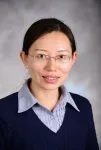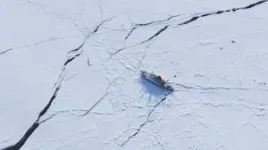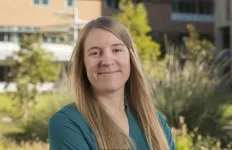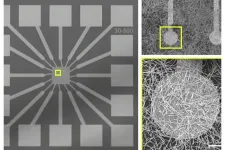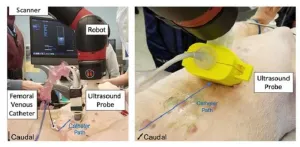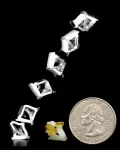(Press-News.org) A University of Texas at Arlington engineering researcher has received a NASA grant to use rotating detonation rocket engines (RDREs) for in-space propulsion to make them more efficient, compact and powerful.
Liwei Zhang, an assistant professor in the Department of Mechanical and Aerospace Engineering (MAE), will lead the $900,000 grant.
“Detonation is very fast combustion. Inside an RDRE, detonation waves spin around in a circle at supersonic speeds. Compared to conventional engines that rely on regular combustion, an RDRE has a theoretically higher efficiency, and can be made smaller and more compact.” Zhang explained. “Our work will focus on the component level, evaluating injectors, combustors and nozzles. We will also study system-level configurations for testing. It’s a collaborative effort among theoretical analyses, computational simulations and experimental measurements to assess and improve the performance of this type of engine.”
Zhang said the work is important because it aims to develop more efficient propulsion systems for space travel, sending people to explore the moon and beyond.
NASA is addressing the call from the National Space Exploration Campaign through the Artemis Program, using new technology to study the Moon in better ways and to prepare for future missions.”
Co-investigators are Frank Lu, professor in MAE, and Grace Brannon and Monica Mengqi Zhan, assistant professors in the Department of Communication.
“Frank played a pivotal role in securing this grant through his expertise in detonation engines,” Zhang said. “He, and our late, beloved Don Wilson (professor in MAE) started the Aerodynamics Research Center (ARC) on campus thirty-seven years ago. Since then, they have led many exciting studies on detonation engines. All testing for our M-STAR project will take place at the ARC.”
Lu said he is “glad to be recognized by NASA for our expertise in rotating detonation engines that can play a role in this game-changing technology. It is also gratifying that NASA recognizes UTA as an institution at the forefront of engagement in underrepresented communities.”
Zhang said the project has educational goals as well. There is a component of K-16 education for underrepresented communities of students.
“We want to recruit and retain them, and empower them to establish careers in space,” Zhang said. “We want younger people to understand that there are ways for them to enter this track. If you have an interest, follow your heart. Many people think of space education as an elite type of study. They’ve been discouraged. It’s not just a technical obstacle but a mental one, too.”
Zhang speaks from experience. As a girl growing up in a small town in central China, she was subtly told that her interests in math and sciences were misplaced. While in college and graduate school, many times, she was the only female in her study group or classroom. She believes some parts of the education may be changed to include students from different identity groups. She said her communication colleagues will create some rich activities to encourage recruitment, retention and life-time engagement of students from different backgrounds in space technology.
“How we communicate educational goals early on in the K-16 education system can have a huge impact on students’ self-efficacy and even educational attainment,” said Brannon, who is a first-generation college student herself. She recognizes how important the role of communication is in encouraging students to set and achieve goals, even if they haven’t been historically well-represented in their specific fields of interest.
Zhang said the education program draws on years of extensive teamwork research on diversity. “We are committed to breaking down barriers by implementing interventions that challenge stereotypes and prejudices. Our goal is to create an inclusive environment that enhances the teamwork experiences of underrepresented minority students and researchers, ultimately bolstering retention rates and fostering innovation.”
Erian Armanios, MAE chair and professor, said this type of project is becoming mainstream at UT Arlington.
“It’s inspiring to witness Liwei’s ability to involve so many constituents of UTA,” Armanios said. “Not only is this on the cutting edge of space travel, it is bound to increase the participation of underrepresented minority students in this exciting field. Harnessing the talents of our diverse UTA community strengthens the project itself and helps grow a stronger University.”
UTA’s grant is part of the NASA MUREP Space Technology Artemis Research (M-STAR), which supports NASA’s Space Technology Mission Directorate (STMD) by fostering and increasing minority-serving institutions’ participation in research and technology development concepts that align with the agency’s needs for upcoming Artemis missions to the moon. The agency chose nine institutions, awarding a total of more than $8 million to carry out their projects.
“When we return humans to the Moon, it will be thanks to the creativity and dedication of researchers across the nation,” said Walt Engelund, deputy associate administrator for programs in STMD. “We’re proud to partner with OSTEM (Office of STEM Engagement) to foster the future of technology development and create opportunities for these institutions to contribute to NASA’s Artemis missions.”
END
UTA developing more powerful rocket engines for space travel
NASA-funded project also includes mentoring opportunities for K-16 students
2023-11-14
ELSE PRESS RELEASES FROM THIS DATE:
A how-to for reducing flooding impacts in coastal towns
2023-11-14
A University of Texas at Arlington civil engineering researcher is determining what strategies are most effective at lessening flooding in coastal communities.
Michelle Hummel, a civil engineering assistant professor, is using a $499,973 National Oceanic and Atmospheric Administration (NOAA) grant to study the benefits and costs of flood-reduction strategies aimed at increasing coastal resilience to storms and sea-level rise.
Hummel and her colleague, Kevin Befus of the University of Arkansas, will apply advanced ...
NJIT scientists uncover aurora-like radio emission above a sunspot
2023-11-13
In a study published in Nature Astronomy, astronomers from New Jersey Institute of Technology’s Center for Solar-Terrestrial Research (NJIT-CSTR) have detailed radio observations of an extraordinary aurora-like display — occurring 40,000 km above a relatively dark and cold patch on the Sun, known as a sunspot.
Researchers say the novel radio emission shares characteristics with the auroral radio emissions commonly seen in planetary magnetospheres such as those around Earth, Jupiter and Saturn, as well as certain low-mass stars.
The discovery offers new insights into the origin of such intense solar radio bursts and potentially opens new avenues ...
Experimental brain-like computing system more accurate with custom algorithm
2023-11-13
FINDINGS
An experimental computing system physically modeled after the biological brain “learned” to identify handwritten numbers with an overall accuracy of 93.4%. The key innovation in the experiment was a new training algorithm that gave the system continuous information about its success at the task in real time while it learned.
The algorithm outperformed a conventional machine-learning approach in which training was performed after a batch of data has been processed, producing 91.4% accuracy. The researchers also showed that memory of past inputs stored in the system itself enhanced learning. In contrast, other ...
Researchers develop gel to deliver cancer drugs for solid tumors
2023-11-13
Intratumoral therapy – in which cancer drugs are injected directly into tumors – is a promising treatment option for solid cancers but has shown limited success in clinical trials due to an inability to precisely deliver the drug and because most immunotherapies quickly dissipate from the site of injection. A team of researchers from Mass General Brigham, in collaboration with colleagues at the Koch Institute for Integrative Cancer Research, has developed a gel delivery system that overcomes these challenges. The gel is injectable but solidifies upon delivery; contains an imaging agent for visualization under CT scan; and can hold a high ...
Using deep learning to process raw photoacoustic channel data and guide cardiac interventions
2023-11-13
Cardiovascular diseases rank among the top causes of death across the world, and cardiac interventions are similarly very common. For example, cardiac catheter ablation procedures, which are used to treat arrythmias, number in several tens of thousands per year in the US alone. In these procedures, surgeons insert a thin, flexible tube called a catheter into the femoral vein in the leg and navigate their way up to the heart, where the problematic tissue is destroyed using cold or focused radiation.
Even though cardiac catheter-based procedures are considered minimally invasive, the position ...
The Long Jump: Athletic, insect-scale long jumping robots reach where others can't.
2023-11-13
A team of engineers from the University of Illinois has published the first known study documenting the long-jumping motion of 3D-printed insect-scale robots.
The new study, published in the journal Smart Materials and Structures, follows a previous publication that documented the same lab’s investigation of vertical jumping in insect-scale robots. The study is led by Professor Sameh Tawfick, an associate professor and Ralph A. Andersen Faculty Scholar in the Department of Mechanical Science and Engineering. His lab, the Kinetic Materials Research Group, studies the ...
UMD engineers’ ‘cooling glass’ blasts building heat into space
2023-11-13
University of Maryland researchers aiming to combat rising global temperatures have developed a new “cooling glass” that can turn down the heat indoors without electricity by drawing on the cold depths of space.
The new technology, a microporous glass coating described in a paper published in the journal Science, can lower the temperature of the material beneath it by 3.5 degrees Celsius at noon, and has the potential to reduce a mid-rise apartment building’s yearly carbon emissions by 10%, according to the research team led by Distinguished University Professor Liangbing Hu in the Department of Materials ...
University of Oklahoma engineer elected as fellow member of Optica
2023-11-13
Optica, an international association in optics and photonics, recently announced the election of University of Oklahoma engineering professor Javier Jo, Ph.D., as a Fellow member.
Jo, a faculty member in the School of Electrical and Computer Engineering, was honored for his contributions to integrating optical imaging and artificial intelligence for biomedical applications. His research focuses on developing optical sensing and imaging technologies to understand pathophysiological mechanisms in human diseases and improve their clinical management.
“Dr. Jo’s ...
University of Toronto Engineering study finds bigger datasets might not always be better for AI models
2023-11-13
From ChatGPT to DALL-E, deep learning artificial intelligence (AI) algorithms are being applied to an ever-growing range of fields. A new study from University of Toronto Engineering researchers, published in Nature Communications, suggests that one of the fundamental assumptions of deep learning models — that they require enormous amounts of training data — may not be as solid as once thought.
Professor Jason Hattrick-Simpers and his team are focused on the design of next-generation materials, from catalysts that convert captured carbon into fuels to non-stick surfaces that keep airplane wings ice-free.
One ...
Acupuncture may offer limited relief to patients with chronic hives
2023-11-13
Annals of Internal Medicine Tip Sheet
@Annalsofim
Below please find summaries of new articles that will be published in the next issue of Annals of Internal Medicine. The summaries are not intended to substitute for the full articles as a source of information. This information is under strict embargo and by taking it into possession, media representatives are committing to the terms of the embargo not only on their own behalf, but also on behalf of the organization they represent.
----------------------------
1. Acupuncture may offer limited relief to patients with chronic hives
Abstract: https://www.acpjournals.org/doi/10.7326/M23-1043
Editorial: ...
LAST 30 PRESS RELEASES:
ASH 2025: New study shows that patients can safely receive stem cell transplants from mismatched, unrelated donors
Protective regimen allows successful stem cell transplant even without close genetic match between donor and recipient
Continuous and fixed-duration treatments result in similar outcomes for CLL
Measurable residual disease shows strong potential as an early indicator of survival in patients with acute myeloid leukemia
Chemotherapy and radiation are comparable as pre-transplant conditioning for patients with b-acute lymphoblastic leukemia who have no measurable residual disease
Roughly one-third of families with children being treated for leukemia struggle to pay living expenses
Quality improvement project results in increased screening and treatment for iron deficiency in pregnancy
IV iron improves survival, increases hemoglobin in hospitalized patients with iron-deficiency anemia and an acute infection
Black patients with acute myeloid leukemia are younger at diagnosis and experience poorer survival outcomes than White patients
Emergency departments fall short on delivering timely treatment for sickle cell pain
Study shows no clear evidence of harm from hydroxyurea use during pregnancy
Long-term outlook is positive for most after hematopoietic cell transplant for sickle cell disease
Study offers real-world data on commercial implementation of gene therapies for sickle cell disease and beta thalassemia
Early results suggest exa-cel gene therapy works well in children
NTIDE: Disability employment holds steady after data hiatus
Social lives of viruses affect antiviral resistance
Dose of psilocybin, dash of rabies point to treatment for depression
Helping health care providers navigate social, political, and legal barriers to patient care
Barrow Neurological Institute, University of Calgary study urges “major change” to migraine treatment in Emergency Departments
Using smartphones to improve disaster search and rescue
Robust new photocatalyst paves the way for cleaner hydrogen peroxide production and greener chemical manufacturing
Ultrafast material captures toxic PFAS at record speed and capacity
Plant phenolic acids supercharge old antibiotics against multidrug resistant E. coli
UNC-Chapel Hill study shows AI can dramatically speed up digitizing natural history collections
OYE Therapeutics closes $5M convertible note round, advancing toward clinical development
Membrane ‘neighborhood’ helps transporter protein regulate cell signaling
Naval aviator turned NPS doctoral student earns national recognition for applied quantum research
Astronomers watch stars explode in real time through new images
Carbon-negative building material developed at Worcester Polytechnic Institute published in matter
Free radicals caught in the act with slow spectroscopy
[Press-News.org] UTA developing more powerful rocket engines for space travelNASA-funded project also includes mentoring opportunities for K-16 students
